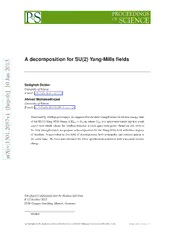Table Of ContentA decomposition for SU(2) Yang-Mills fields
3
1
0
2
n
a
J
0 SedighehDeldar∗
1
UniversityofTehran
] E-mail:[email protected]
h
t
- AhmadMohamadnejad
p
e UniversityofTehran
h
E-mail:[email protected]
[
1
v MotivatedbyAbeliandominance,wesupposethatthefieldstrengthtensorinthelowenergylimit
7
oftheSU(2)Yang-MillstheoryisGmn =Gmn n,whereGmn isaspace-timetensorandnisaunit
5
0 vectorfieldwhichselectstheAbeliandirectionateachspace-timepoint. Basedonthisformof
2
thefieldstrengthtensor,weproposeadecompositionfortheYang-Millsfieldwiththreedegrees
.
1
offreedom. Itseemsthatbythiskindofdecompostion,bothmonopolesandvorticesappearat
0
3 the same time. We have also obtainedthe Dirac quantizationconditionwith a rescaled electric
1
charge.
:
v
i
X
r
a
XthQuarkConfinementandtheHadronSpectrum
8-12October2012
TUMCampusGarching,Munich,Germany
∗
Speaker.
(cid:13)c Copyrightownedbytheauthor(s)underthetermsoftheCreativeCommonsAttribution-NonCommercial-ShareAlikeLicence. http://pos.sissa.it/
AdecompositionforSU(2)Yang-Millsfields SedighehDeldar
1. Decompositionofthe Yang-Millsfield
Even though the gauge field Am is a proper order parameter for describing the Yang-Mills
theory initsultraviolet limit,thelowenergy limitoftheYang-Millstheorybehaves likeadualsu-
perconductor [1]and some other order parameters maybecome more appropriate. Therefore, one
can decompose the Yang-Mills fields to new collective variables. Decomposing the Yang-Mills
fields has been done before by different methods [2]. These decompositions pursue different pur-
posesinparticularinconnection withtheissueofquarkconfinementinquantumchromodynamics
(QCD). We propose a decomposition based on the especial form of Gmn which is appropriate for
theinfrared regimeoftheSU(2)Yang-MillstheorywithAbeliandominance [3]
Gmn =Gmn n, (1.1)
where Gmn is a colorless tensor and n is an isotriplet unit vector field which gives the Abelian
direction ateach space-time point. Onecanconstruct anorthogonal basis forthecolorspace by n
anditsderivatives, andthenexpandthegaugefieldAm
Am =Cm n+f 1¶ m n+f 2n׶ m n. (1.2)
ForSU(2)fieldstrength tensor, wehave
Gmn =¶ m An −¶ n Am +gAm ×An . (1.3)
SubstitutingEq. (1.2)in(1.3)andchangingthevariablesf = r ,1+gf = s ,wegetthefollowing
1 g2 2 g
decomposition
1 r s
Am =Cm n+ ¶ m n×n+ ¶ m n+ n׶ m n. (1.4)
g g2 g2
ItiseasytoshowthatEq. (1.1)issatisfiedifCm isdecomposed asthefollowing
1
Cm = (s¶ m r −r¶ m s ), (1.5)
ga2
A constraint on r and s is obtained as well: r 2+s 2 =a2, a is constant. Therefore, Cm is re-
stricted andit hasone dynamical degree offreedom because itdepends on r and s whichare not
independent. Thus,therearetotallythreedynamicaldegreesoffreedom: twofornandoneforCm .
Thefieldstrength tensor canbe rewritten in termsof electric and magnetic fieldstrength ten-
sors, Fmn andHmn ,respectively:
Gmn =(Fmn +Hmn )n, (1.6)
where
1
Fmn =¶ m Cn −¶ n Cm , Hmn =−g′n.(¶ m n׶ n n), (1.7)
and 1 = 1−a2 whereg′ istherescaled electriccharge.
g′ g g3
2
AdecompositionforSU(2)Yang-Millsfields SedighehDeldar
2. Vortices and monopoles
Vorticeswillappearinastopologicalsingularitiesofthescalarfield(r ,s ),if"two-dimensional
hedgehog ansatz"ischosen
−→
r
(r ,s )=a =a(cos(mj ),sin(mj )), m∈Z, (2.1)
r
wherej istheazimuthalcircularcoordinate of S1. UsingEq. (2.1)inEq. (1.5)oneobtains
R
Cm =−m¶ m j ⇒Cr =Cz=0, Cj =−m ⇒−→B =−2md (r)bk. (2.2)
g gr gr
Thisrepresents avortex-like objectwhichshowsthatthemagneticfieldissingularonthezaxis.
Toobtainthemagneticmonopole, wechooseahedgehog configuration n= ra andweget,
r
−→ 1 m 1
B =Bbr, B=Hqj =−g′n.(¶ q n׶ j n)=−g′r2, m∈Z. (2.3)
′
From Eq. (2.3) one gets gg =m. This is the Dirac quantization condition, but with a rescaled
m
′
electric charge g. Forourdecomposition, therelation between gandg is
m
a
gg =m(1−( )2). (2.4)
m
g
If a goes to zero, the familiar Dirac quantization condition would be restored. In addition, in this
limitourdecompositionreducestotheChodecompositionwheretheU(1)fieldisnolongerdecom-
posed, and consequently no vortices appear. So, it seems that the presence of vortices influences
theDiracquantization condition byrescaling theelectric coupling orcharge.
3. Conclusion
We conjecture a special form of the field strength tensor for the infrared limit of the SU(2)
Yang-MillstheorytoproposeadecompositionfortheYang-Millsfield. Inthisdecomposition both
vorticesandmonopolescanappearatthesametime. Diracquantization conditionisalsoobtained,
butwitharescaled colorcharge.
References
[1] Y.Nambu,Phys.Rev.D104262(1974);M.Creutz,Phys.Rev.D102696(1974);G.’tHooft,High
EnergyPhysics,EditoriceCompositori,Bologna(1975);S.Mandelstam,Phys.Report23245(1976);
A.Polyakov,Nucl.Phys.B120,429(1977);G.’tHooft,Nucl.Phys.B153,141(1979).
[2] Y.M.Cho,Phys.Rev.D21(1980)1080;Phys.Rev.D232415(1981).L.FaddeevandA.J.Niemi,
Phys.Rev.Lett.821624(1999).S.V.Shabanov,Phys.Lett.B458322(1999);Phys.Lett.B463263
(1999).
[3] T.SuzukiandI.Yotsuyanagi,Phys.Rev.D424257(1990);J.D.Stack,S.D.Neiman,andR.
Wensley,Phys.Rev.D503399(1994);H.ShibaandT.Suzuki,Phys.Lett.B333461(1994).
3

